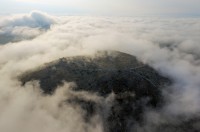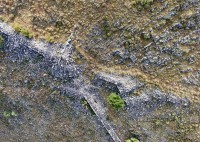 A team of archaeologists from the University of Gothenburg and University of Bournemouth has discovered the ruins of a previously unknown ancient city near the village of Vlochós, about 200 miles north of Athens. A smattering of ancient remains were known to be on Strongilovoúni hill on the plains of Western Thessaly, but they were believed to belong to a small rural settlement. Fortifications, more than eight feet high in some places, are visible on the hill, as are the remains of towers and city gates. The new discoveries lower on the hill were obscured by layers of silt and sediment deposited by the river Enipeas.
A team of archaeologists from the University of Gothenburg and University of Bournemouth has discovered the ruins of a previously unknown ancient city near the village of Vlochós, about 200 miles north of Athens. A smattering of ancient remains were known to be on Strongilovoúni hill on the plains of Western Thessaly, but they were believed to belong to a small rural settlement. Fortifications, more than eight feet high in some places, are visible on the hill, as are the remains of towers and city gates. The new discoveries lower on the hill were obscured by layers of silt and sediment deposited by the river Enipeas.
This year archaeologists launched the first major systematic exploration of the hill, which has also been virtually ignored by scholarly research other than a few tangential descriptions of the archaeological remains. The Vlochós Archaeological Project (VLAP) is remedying this oversight starting with a non-invasive investigation of the site using technology like Network Real Time Kinematic GPS for precise measurements, drone photogrammetry and ground-penetrating radar.
During a mere two weeks in September, the VLAP team discovered that this supposedly sleepy backwater was actually a thriving polis.
“We found a town square and a street grid that indicate that we are dealing with quite a large city. The area inside the city wall measures over 40 hectares. We also found ancient pottery and coins that can help to date the city. Our oldest finds are from around 500 BC, but the city seems to have flourished mainly from the fourth to the third century BC before it was abandoned for some reason, maybe in connection with the Roman conquest of the area.”
[University of Gothenburg PhD student and fieldwork leader Robin] Rönnlund believes that the Swedish-Greek project can provide important clues as to what happened during this violent period in Greek history.
“Very little is known about ancient cities in the region, and many researchers have previously believed that western Thessaly was somewhat of a backwater during Antiquity. Our project therefore fills an important gap in the knowledge about the area and shows that a lot remains to be discovered in the Greek soil.”
 The fortifications on the hill were built in the late Archaic to the Hellenistic periods (ca. 500-200 B.C.), but there is evidence of repairs done in the Late Roman/Early Byzantine eras, so if it was entirely abandoned for a stretch after the Roman conquest, it was reoccupied, or at least strengthened by the end of the Roman period.
The fortifications on the hill were built in the late Archaic to the Hellenistic periods (ca. 500-200 B.C.), but there is evidence of repairs done in the Late Roman/Early Byzantine eras, so if it was entirely abandoned for a stretch after the Roman conquest, it was reoccupied, or at least strengthened by the end of the Roman period.
The exploration of the site will continue next August during the second season of the project. Archaeologists hope a thorough ground-penetrating radar study will answer some of the questions about the development of the city.
Here is some picturesque drone footage of the remains on the hill taken from 1500 feet above ground level.
[youtube=https://youtu.be/wWjY-4e-CRg&w=430]